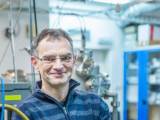
Nacházíte se
Semináře sekce
Úterý, 24.04.2018 13:00
Dr. Philippe Veber (Institut Lumière Matière, Université Claude Bernard Lyon 1, France)
Pondělí, 23.04.2018 10:00
R. F. Mamin (Zavoisky Physical-Technical Institute of FIC KazanSC RAS, Sibirskii tract 10/7, Kazan, Russia)
Čtvrtek, 19.04.2018 10:00
Michal Šindler (Fyzikální ústav AV ČR, oddělení magnetik a supravodičů)
Abstract: Far-infrared techniques played a crucial role in the
experimental validation of Bardeen–Cooper–Schrieffer (BCS) theory and
they continue to provide fundamental information about condensate,
quasiparticle and vortex behaviour in both equilibrium and
non-equilibrium states of superconductors.
In this talk, we will focus on the response of thin superconducting
NbN films. We confirmed that their equilibrium conductivity follows the
conventional BCS theory. Application of a dc magnetic field induces
vortices in the films, which leads to qualitatively different responses,...
Středa, 18.04.2018 13:00
Dr. Philippe Veber (Institut Lumière Matière, Université Claude Bernard Lyon 1, France)
Úterý, 17.04.2018 15:00
I. Titvinidze (Technische Universität Graz., Austria)
Abstract: We consider a system consisting of several correlated monoatomic layers sandwiched between two metallic leads. In addition to the local Hubbard interaction we also take the long-range Coulomb interaction into account, which causes electronic charge reconstruction in the correlated layers, as well as in the leads. The non-equilibrium situation is driven by applying a bias voltage to the leads. We investigate the steady-state behavior of the system for different parameters (bias voltage, interaction strength, hybridization strength between leads and the correlated...
Pondělí, 16.04.2018 15:00
Jorge P. Zubelli (IMPA, Rio de Janeiro, Brazil)
Abstract:
In this talk we shall survey recent research on inverse problems, developed by our group at IMPA's Laboratory for Analysis and Mathematical Modelling.
On the methodological side, we have developed non-intrusive resampling tools [1] as well as optimization techniques [2,3,4,5]. Such tools have proven very effective to tackle a number of relevant problems in Mathematical Physics, Finance, and Biology and are naturally extensible to other fields.
We shall then illustrate the method with an application to biophysical systems, with a case study of the uncertain...
Pondělí, 16.04.2018 11:00
Benedikt Scharf (Universität Würzburg)
Due to their large bulk band gap, bismuthene, antimonene, and arsenene on a SiC substrate offer intriguing new opportunities for room-temperature quantum spin Hall (QSH) applications. We show that for experimentally relevant armchair nanoribbons, we find a distinct behavior of the gap induced in the QSH edge states for out-of-plane magnetic fields (a few meV) versus in-plane magnetic fields (negligible gap) which is the hallmark of their topological origin. Further, we predict experimentally testable fingerprints of this behavior in the LDOS and in ballistic magnetotransport.
Pátek, 13.04.2018 14:00
Prof. Udo Schwingenschloegl (Department of Computational Physics & Materials Science King Abdullah University of Science and Technology (KAUST), Saudi Arabia)
The presentation will address recent developments related to elemental 2D materials beyond graphene, with a focus on silicene, germanene, and arsenene. Several examples will be discussed in order to illustrate how computational theory based on first-principles calculations can contribute to understanding basic physical and chemical phenomena in 2D condensed matter. Silicene is of particular interest due to its compatibility with established Si technology. Regrettably, strong interaction with common substrates eliminates the Dirac states. Alternative substrates will be analyzed and the effects...
Úterý, 10.04.2018 15:00
František Slanina (Department of Condensed Matter Theory, Czech Acad. of Sci.)
Abstract: We investigate analytically a simple microfluidic device consisting of a tube with non-uniform but spatially periodic diameter (a contraction-expansion array). The fluid is driven back and forth by a pump and carries colloidal particles. Although the net flow of the fluid is zero, the particles move preferentially in one direction due to ratchet mechanism, which occurs by simultaneous effect of inertial hydrodynamics and Brownian motion. Analytical treatment of the underlying advection-diffusion problem is done using Fick-Jacobs mapping on effective one-dimensional...



